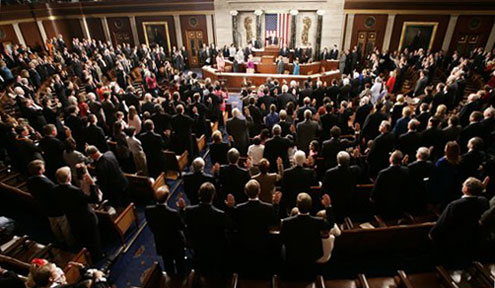Pension tensions continue to mount
Retirement benefits for government employees debated, as economy and deficit reduction remain in the spotlight.

Gerald Herbert/AP
Retirement benefits for government workers continue to receive scrutiny early in 2012, as budget-cutting once again takes center stage and the presidential campaign gains momentum.
House and Senate conferees return to Washington on Monday to pick up the payroll tax cut extension debate -- proposals on the table include increasing employees' contributions to their pensions -- while a House Oversight and Government Reform subcommittee plans to hold a hearing Wednesday on bolstering the federal retirement system. In February, President Obama will unveil his 2013 budget proposal, which could include a recommendation to increase the amount of money federal workers pay into their pensions.
And that's just at the federal level. Many states are weighing the potential savings from slashing government employees' pensions against the backdrop of an economy that continues to struggle. Whether it's at the state or the federal level, the debate revolves around a central question: Are public pensions too generous? The answer to that question is all over the map, figuratively and literally.
"Defined benefit pensions are without question the most efficient way to provide retirement security to our nation's working men and women," New York State Comptroller Thomas DiNapoli said Thursday. "In times of fiscal distress, we should be focusing on ways to strengthen public pension plans, not take them away."
DiNapoli, along with North Carolina State Treasurer Janet Crowell and other policy experts, spoke at a National Press Club event that looked at retirement security issues across the country.
In New York state, where 385,000 government retirees receive pensions, the average annual pension is about $19,000, he said. In North Carolina, the average pension is $22,000 per year, Crowell said. According to the nonprofit National Public Pension Coalition, 30 percent of public employees do not receive Social Security benefits.
That's less money than what some federal workers receive from their pensions. Bloomberg reported Wednesday that one in every 125 retired federal civilian workers receives more than $100,000 in annual benefits. Among those high earners: former speaker of the House and current Republican presidential candidate Newt Gingrich, and retired lawmakers and congressional staff. Those six-figure recipients, however, accounted for only a fraction of more than 1 million federal retirees, according to the report.
Federal pensions are calculated using the high-three formula -- the average basic pay a federal worker earned during any three consecutive years of service. The average federal salary is about $75,000. In addition, federal workers covered under the Federal Employees Retirement System receive Social Security and money from the savings in their 401(k)-style Thrift Savings Plan. There are legislative proposals floating around that would change the high three to a high-five formula.
Still, reports of six-figure federal retirement benefits and the $674.2 billion shortfall in federal pension programs amid major deficit-reduction efforts will keep public pension reform in the spotlight. Hank Kim, executive director and counsel at the National Conference on Public Employee Retirement Systems, said money saved from reducing pension benefits should go toward strengthening a retirement system not necessarily overall deficit reduction. "We've seen manageable, run-of-the-mill problems with these [state] systems shamefully blown up into epic proportions, all so that officials have an excuse to slash the pensions of hardworking Americans in the name of balancing the budget," he said.
Kim, whose trade association deals with state pension plans and issues, believes the public pension model is sustainable and could be extended to the private sector.







